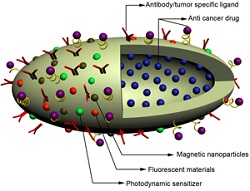 |
| Nanoparticle with multiple surfaces loaded to diagnose and treat cancer--Courtesy of the University of Cincinnati |
Researchers at the University of Cincinnati and other U.S. and Chinese institutions have developed a drug-carrying nanoparticle with a dual-surface structure that can play multiple roles in cancer treatment including diagnosis, fluorescent signaling and chemotherapy delivery.
The nanostructure has a double-sided, or Janus, surface that allows it to house several components for cancer detection and targeting, as well as a protected interior for cancer drugs. Normally, nanoparticles have less surface area on which to hold multiple components, limiting their capacity, but the Janus particles give the vehicle more room to perform different functions.
According to a university report, these new particles have a threefold method of action. Their surfaces can be loaded with antibodies and tumor-specific ligands that help the nanoparticle accumulate at the site of a tumor, aiding in an early diagnosis. Then, for the purposes of either drug delivery or surgery, they can carry fluorescence to specific cancer cells, making them easier to locate. And for a final punch, their inside surfaces can hold cancer drugs, which, because of the targeting capability of the particles, can be set to release only at the site of the tumor, resulting in fewer side effects.
"In this effort, we're using existing basic nano systems, such as carbon nanotubes, graphene, iron oxides, silica, quantum dots and polymeric nano materials in order to create an all-in-one, multidimensional and stable nano carrier that will provide imaging, cell targeting, drug storage and intelligent, controlled drug release," researcher Donglu Shi of the University of Cincinnati said in a statement.
The team, which includes scientists from the University of Cincinnati, the University of Houston, Stanford University and Tongji University in Shanghai, will present their research at the annual Materials Science & Technology Conference in Montreal.
- here's the UC report